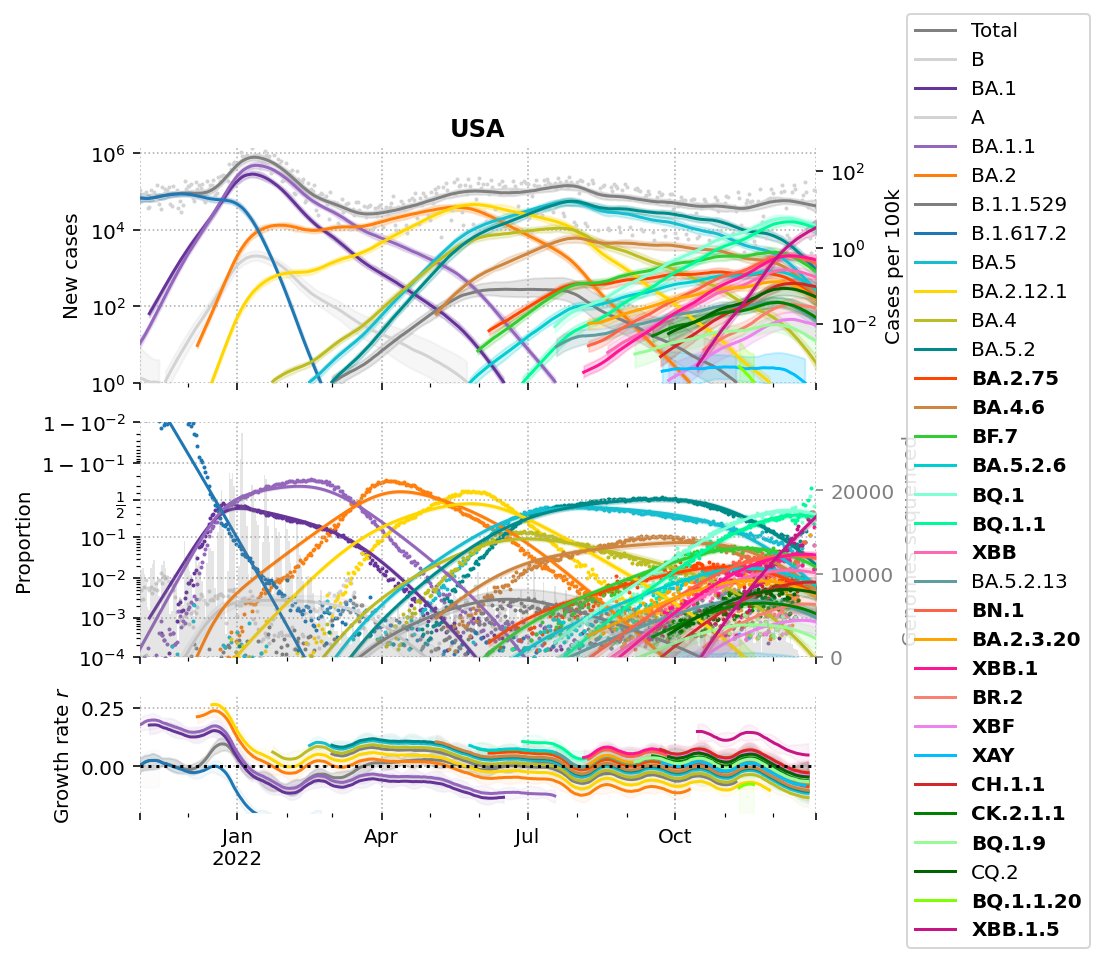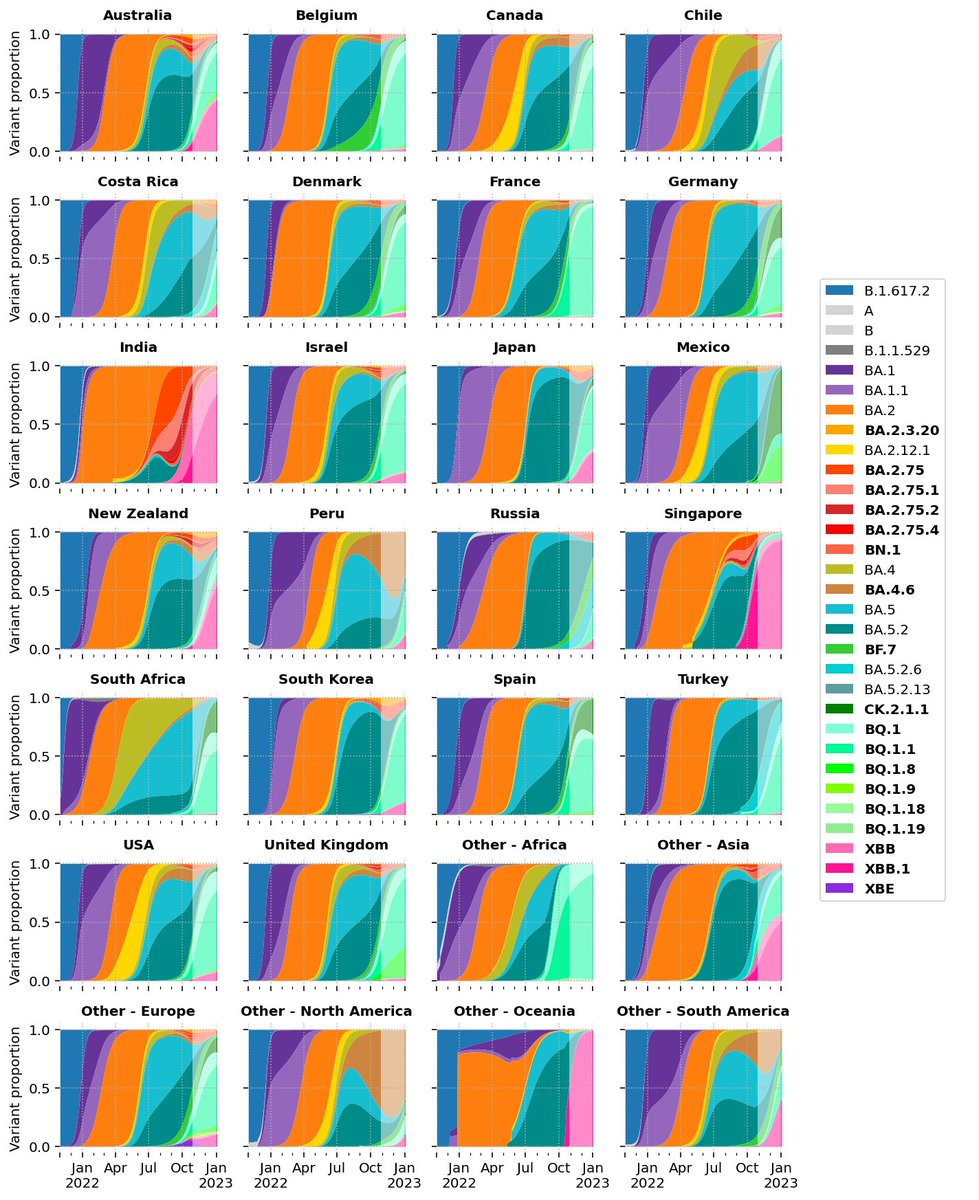Some musings on SARS-CoV-2 evolution
TLDR: The share of the variant zoo increased further with BQ.1* and XBB* at the top.
But there are interesting patterns underneath which can be illustrated by one exotic lineage: CH.1.1.
It’s rare, but it rises as fast as BQ.1.1. Why?

TLDR: The share of the variant zoo increased further with BQ.1* and XBB* at the top.
But there are interesting patterns underneath which can be illustrated by one exotic lineage: CH.1.1.
It’s rare, but it rises as fast as BQ.1.1. Why?


Background: There is a whole zoo of omicron sublineages, often defined by a range of mutations enabling partial immune escape.
Looking at the crude global increase over the past 28d CH.1.1 is one that has increased at the upper end of the flock.
Looking at the crude global increase over the past 28d CH.1.1 is one that has increased at the upper end of the flock.

Why does it spread as fast as BQ.1.1?
It turns out that it has independently acquired *the same set of key RBD mutations* as BQ.1.1.
Yet CH.1.1 derives from BA.2, while BQ.1.1 is a descendant of BA.5 though.
It turns out that it has independently acquired *the same set of key RBD mutations* as BQ.1.1.
Yet CH.1.1 derives from BA.2, while BQ.1.1 is a descendant of BA.5 though.

CH.1.1 makes up about 1% of cases in the U.K., 2% in Australia and 1-3% across Asia.
BQ.1.1 comprises 10-60% of cases except for Asia and Oceania.
The freq of CH.1.1 is considerably lower because it started spreading around *a month later later* than BQ.1.1, around October
BQ.1.1 comprises 10-60% of cases except for Asia and Oceania.
The freq of CH.1.1 is considerably lower because it started spreading around *a month later later* than BQ.1.1, around October

So timing and location matter in a race with many lineages of almost equal potential.
This makes it very difficult to predict the eventual winner.
It may be that CH.1.1 ends up as a footnote.
Whoever wins though is very likely to have predictable characteristics.
This makes it very difficult to predict the eventual winner.
It may be that CH.1.1 ends up as a footnote.
Whoever wins though is very likely to have predictable characteristics.

The fact that the number of RBD variants leads to consistent selective advantages has been demonstrated before, eg in analyses by @TWenseleers and @CorneliusRoemer
But the extent and consistency of convergence has intriguing consequences.
But the extent and consistency of convergence has intriguing consequences.
https://twitter.com/TWenseleers/status/1589555000849858560?s=20&t=43TvVchDT-cTDeNN806Lnw
This mode of evolution is in stark contrast to the saltations of Alpha, Delta and Omicron which emerged with ~10-30 concomitant mutations.
One interpretation of these jumps is that they adapted the large spike protein to better fit to human cells.
Such events are unpredictable.
One interpretation of these jumps is that they adapted the large spike protein to better fit to human cells.
Such events are unpredictable.
The gradual immune escape we saw recently, however, is not.
Many of the RBD mutations have been predicted earlier this year as immune escape routes in experiments by @jbloom_lab and @yunlong_cao.
There’s even an online calculator.
jbloomlab.github.io/SARS2_RBD_Ab_e…
Many of the RBD mutations have been predicted earlier this year as immune escape routes in experiments by @jbloom_lab and @yunlong_cao.
There’s even an online calculator.
jbloomlab.github.io/SARS2_RBD_Ab_e…
So the emergence of the recent variant zoo followed predictable patterns.
This I think is reason to be optimistic that we can get ahead of SARS-CoV-2 (and other viruses’) evolution — and design better vaccines.
(At least sometimes, as black swans may also still arise.)
This I think is reason to be optimistic that we can get ahead of SARS-CoV-2 (and other viruses’) evolution — and design better vaccines.
(At least sometimes, as black swans may also still arise.)
Latest analysis report on github. Data aggregated by cov-spectrum from GISAID.
github.com/gerstung-lab/S…
github.com/gerstung-lab/S…
• • •
Missing some Tweet in this thread? You can try to
force a refresh
































